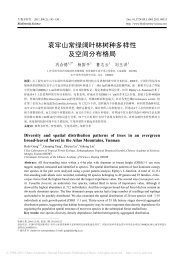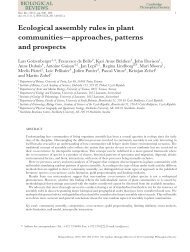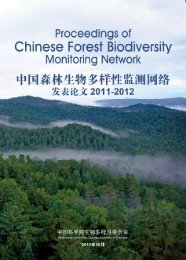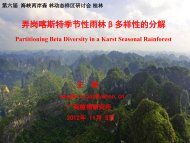the maintenance of species-richness in plant communities
the maintenance of species-richness in plant communities
the maintenance of species-richness in plant communities
Create successful ePaper yourself
Turn your PDF publications into a flip-book with our unique Google optimized e-Paper software.
Ma<strong>in</strong>tenance <strong>of</strong> <strong>species</strong>-<strong>richness</strong> <strong>in</strong> <strong>plant</strong> <strong>communities</strong> 119<br />
IV. DEFINITION OF A PLANT’S NICHE<br />
The niche <strong>of</strong> a <strong>plant</strong> is taken here to be <strong>the</strong> def<strong>in</strong>ition <strong>of</strong> its total relationship with<br />
its environment, both physico-chemical and biotic; such a def<strong>in</strong>ition necessarily<br />
<strong>in</strong>cludes a statement <strong>of</strong> <strong>the</strong> role played by <strong>the</strong> <strong>plant</strong> as well as a statement <strong>of</strong> its tolerance.<br />
The present author sees no advantage <strong>in</strong> replac<strong>in</strong>g <strong>the</strong> term ‘niche’, used <strong>in</strong> this sense<br />
by ‘ecotope’, as suggested elsewhere (Whittaker, Lev<strong>in</strong> & Root, 1973). My usage <strong>of</strong><br />
‘niche’ is essentially <strong>in</strong> agreement with that <strong>of</strong> Richards (1969) and Wuenscher<br />
(1969, 1974). Four component niches have to be recognized <strong>in</strong> a complete def<strong>in</strong>ition<br />
<strong>of</strong> a <strong>plant</strong>’s niche.<br />
(i) The habitat niche, i.e. <strong>the</strong> physical and chemical limits tolerated by <strong>the</strong> mature<br />
<strong>plant</strong> <strong>in</strong> nature. The def<strong>in</strong>ition should <strong>in</strong>clude an expression <strong>of</strong> <strong>the</strong> k<strong>in</strong>ds <strong>of</strong> fluctuations<br />
from <strong>the</strong> mean climatic conditions which favour <strong>the</strong> <strong>plant</strong>’s vegetative development.<br />
(ii) The life-form niche, <strong>in</strong>clud<strong>in</strong>g an expression <strong>of</strong> size and annual productivity as<br />
well as three-dimensional pattern.<br />
(iii) The phenological niche, i.e. <strong>the</strong> pattern <strong>of</strong> seasonal development.<br />
(iv) The regeneration niche, i.e. an expression <strong>of</strong> <strong>the</strong> requirements for a high chance<br />
<strong>of</strong> success <strong>in</strong> <strong>the</strong> replacement <strong>of</strong> one mature <strong>in</strong>dividual by a new mature <strong>in</strong>dividual <strong>of</strong><br />
<strong>the</strong> next generation, concern<strong>in</strong>g all <strong>the</strong> processes and characters <strong>in</strong>dicated <strong>in</strong> Table 2.<br />
The habitat niche is <strong>the</strong> <strong>plant</strong>’s address. The life-form and phenological niches are<br />
<strong>the</strong> <strong>plant</strong>’s pr<strong>of</strong>ession. The regeneration niche <strong>in</strong>cludes elements <strong>of</strong> both address and<br />
pr<strong>of</strong>ession.<br />
Hutch<strong>in</strong>son’s (1957) idea <strong>of</strong> recogniz<strong>in</strong>g a ‘potential niche’ (that effective <strong>in</strong> <strong>the</strong><br />
absence <strong>of</strong> competitors and predators) and a ‘realized niche’ (that effective <strong>in</strong> <strong>the</strong><br />
presence <strong>of</strong> competitors and predators) can be applied to all four aspects <strong>of</strong> <strong>the</strong> niche<br />
but is particularly important for <strong>the</strong> habitat niche.<br />
Before consider<strong>in</strong>g examples <strong>of</strong> differentiation <strong>in</strong> <strong>the</strong> regeneration niche, it is<br />
necessary to recapitulate briefly what is known <strong>of</strong> <strong>the</strong> process <strong>of</strong> regeneration <strong>in</strong> <strong>the</strong><br />
different major types <strong>of</strong> <strong>plant</strong> community.<br />
V. PATTERNS OF REGENERATION IN DIFFERENT PLANT COMMUNITIES<br />
Four major types <strong>of</strong> vegetation may be recognized <strong>in</strong> this context, determ<strong>in</strong>ed by <strong>the</strong><br />
dom<strong>in</strong>ant life-forms present: forests and woodlands, shrub-dom<strong>in</strong>ated <strong>communities</strong>,<br />
grasslands and associations <strong>of</strong> ephemeral herbs.<br />
In most natural forests regeneration <strong>in</strong>volves clear<strong>in</strong>gs <strong>of</strong> some k<strong>in</strong>d, but <strong>the</strong> size <strong>of</strong><br />
<strong>the</strong> clear<strong>in</strong>gs varies enormously. The two extremes are represented by forests suffer<strong>in</strong>g<br />
occasional sheet-destruction by fire and those with gaps created by <strong>the</strong> fall <strong>of</strong> s<strong>in</strong>gle<br />
trees or branches. Intermediate types <strong>in</strong>clude those <strong>in</strong> which gaps <strong>of</strong> 0.1-1-0 ha are<br />
caused by cyclone damage (Webb, 1958; Whitmore, 1974) and those with strips <strong>of</strong><br />
dead and dy<strong>in</strong>g trees somehow related to strong and constant w<strong>in</strong>ds (Oshima, Kimura,<br />
Iwaki & Kuroiwa, 1958; Iwaki & Totsuka, 1959; Sprugel, 1976). In many areas<br />
occasional regeneration <strong>in</strong> sheets after fire alternates with a patchwork regeneration
















